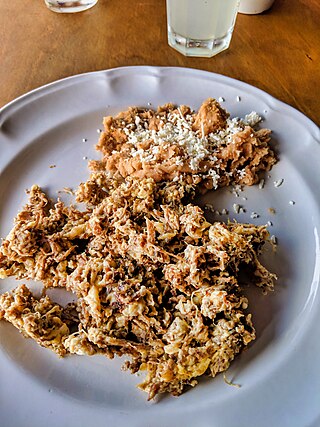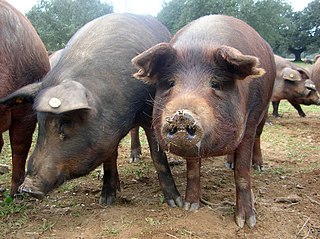
Spanish cuisine consists of the traditions and practices of Spanish cooking. It features considerable regional diversity, with important differences between the traditions of each of Spain's regional cuisines.

Puerto Rican cuisine consists of the cooking style and traditional dishes original to Puerto Rico. It has been primarily a fusion influenced by the ancestors of the Puerto Rican people: the indigenous Taínos, Spanish Criollos and sub-Saharan African slaves. As a territory of the United States, the culinary scene of Puerto Rico has also been moderately influenced by American cuisine.

Corn nuts, also known as toasted corn, are a snack food made of roasted or deep-fried corn kernels. It is referred to as cancha in Peru and chulpi in Ecuador.

Chicharrón is a dish generally consisting of fried pork belly or fried pork rinds. Chicharrón may also be made from chicken, mutton, or beef.

MachacaSpanish:[maˈtʃaka] is a traditionally dried meat, usually spiced beef or pork, that is rehydrated and then used in popular local cuisine in Northern Mexico and the Southwestern United States. It is also readily available in many groceries and supermarkets in these areas. In areas where the dried meat product is not easy to obtain, slow-cooked roast beef (brisket) or skirt steak shredded and then fried is sometimes substituted.

Jamón is a type of dry-cured ham produced in Spain. It is one of the most globally recognized food items of Spanish cuisine. It is also regularly a component of tapas.

Castilian-Leonese cuisine refers to the typical dishes and ingredients of the region of Castile and León in Spain. This cuisine is known for its cooked dishes (guiso) and its grilled or roasted meats (asado), its high-quality wines, the variety of its desserts, its sausages (embutidos), and its cheeses.

Jamón ibérico, is a variety of jamón or presunto, a type of cured leg of pork produced in Spain and Portugal.

Tocino is bacon in Spanish, typically made from the pork belly and often formed into cubes in Spain. In Caribbean countries, such as Puerto Rico and Cuba, tocino is made from pork fatback and is neither cured nor smoked but simply fried until very crunchy; it is then added to recipes, much like the way lardons are used in French cuisine. In the Philippines, tocino refers to sweetened and cured pork belly.

Extremadura, Spain is known for its different ways of preparing the Iberian pork and mutton. The main characteristics of the traditional Extremaduran cuisine are its simplicity, its lack of clutter and its low cost. It is also a cuisine reflecting a generous spirit, for many of its preparations used to be cooked in large pots to share with visitors, friends, and neighbors. The resulting dishes are eaten with local bread.

The cuts of pork are the different parts of the pig which are consumed as food by humans. The terminology and extent of each cut varies from country to country. There are between four and six primal cuts, which are the large parts in which the pig is first cut: the shoulder, loin, belly and leg. These are often sold wholesale, as are other parts of the pig with less meat, such as the head, feet and tail. Retail cuts are the specific cuts which are used to obtain different kinds of meat, such as tenderloin and ham. There are at least 25 Iberian pork cuts, including jamón.

A pig's trotter, also known as a pettitoe, is the culinary term for a pig's foot. It is used as a cut of pork in various dishes around the world, and experienced a resurgence in the late 2000s.

Sociedad anónima deportiva is a special type of public limited company in Spain. The new legal status was introduced in 1990 to improve financial management and transparency in sports clubs. Many Spanish football and basketball clubs add the suffix S.A.D. to the end of their official name, for example Club Atlético de Madrid, S.A.D.

Aborrajados de plátano maduro is a dish of deep fried plantains stuffed with cheese in Colombian cuisine. Abborrajado refers to an egg and flour batter used to fry certain foods in a manner similar to fritters. In general, aborrajado means a dish of cheese-filled plantains dipped in batter and deep-fried, but the term can be used for other variations of the dish like Aborrajado con Chicharrón, which includes chicharrón, in addition to the basic recipe of plantains and cheese. Guava paste, known as bocadillo in Colombia, is also sometimes included as part of the filling.

Pablo Iglesias Turrión is a Spanish political scientist and former politician. During his political career, he served as Second Deputy Prime Minister and as Minister of Social Rights and 2030 Agenda of the Government of Spain from 2020 to 2021. He also served as Member of the Congress of Deputies from 2016 to 2021, representing Madrid. Iglesias is a co-founder of Podemos, a left-wing political party that he led from 2014 until his resignation in 2021.

Munir Mohand Mohamedi El Kajoui, known simply as Munir, is a professional footballer who plays as a goalkeeper for Saudi Pro League club Al Wehda and the Morocco national team.

The gastronomy of the province of Valladolid comprises the meals, their preparation, and the culinary habits of the province of Valladolid. It is based on barbecued and roast food, especially roasted Spanish cuisine. Wines of high quality highlight the meals.

Pork rind is the culinary term for the skin of a pig. It can be used in many different ways.

Japanese-style peanuts, also known as Japanese peanuts or cracker nuts, are a type of snack food made from peanuts that are coated in a wheat flour dough and then fried or deep-fried. They come in a variety of different flavors. The Mexican version's recipe for the extra-crunchy shell has ingredients such as wheat flour, soy sauce, water, sugar, monosodium glutamate, and citric acid. The snacks are sold in sealed bags.

María Emilia Soria is an Argentine lawyer and politician, currently serving as intendenta (mayor) of General Roca, Río Negro. She belongs to the Justicialist Party.




















